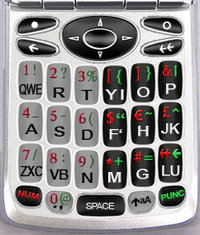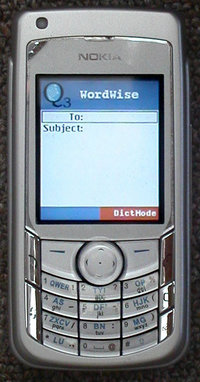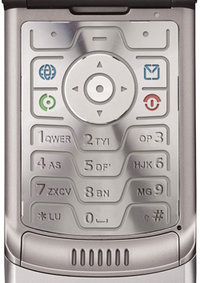EQx |
|
|
|
|
Q: what is the difference between a computer and a phone?
A: the keypad.
|
The Eatoni QWERTY x-column (EQX) keyboard is perfect for email phones: it completely converges a Qwerty keyboard with a telephone keypad. |
EQx means "Eatoni Qwerty with x-columns" and is a keyboard technology designed to equip space-limited devices with efficient QWERTY-style keyboards The 3-column (EQ3) and 6-column (EQ6) designs are the most interesting for contemporary mobile devices.
EQ3
EQ3 is the best system for typing on a mobile phone keypad since:
- it uses the familiar qwerty layout, adapted to a mobile phone keypad.
- its predictions are three times more accurate than predictive text system based on the standard "abc" keyboard.
There is no need to buy a smart phone with a full qwerty keyboard if you have EQ3. EQ3 transforms any phone with a regular keypad into a smart phone, by squeezing a qwerty keyboard onto a regular mobile phone keypad. Eatoni does this compression very carefully to get the maximum value out of each of your keystrokes. The result is a huge improvement over the old-fashioned predictive text systems you're used to. Most people turn off standard predictive text systems since they just don't work very well. But EQ3 changes all that. Never again will you write "call me" and have it come up "call of" since standard predictive systems can't tell the difference between "of" and "me". Never again will "gone home" come up "good good". With EQ3, if you write "call me", it comes up "call me".
Doesn't seem too much to ask, but nobody but Eatoni has gotten it right.
Try the EQ3 demo for Windows at the demos page to become a believer.
If you have a Symbian phone, you can get emailTool, smsTool or ljTool for your phone right now. If you happen to have a Nokia 668x, you will get a keypad with the EQ3 layout to slip into your phone. If you don't, don't worry. An onscreen layout guide is always showing to point out the location of the letters.
Independent research verifies that EQ3 is much better than T9
Researcher S.J Castellucci has found that EQ3 dramatically beats T9 in typing speed. He writes, "While one-handed T9 predictions are consistently the lowest, EQ3 predictions are almost always the fastest. Its QWERTY-styled letter layout distributes keystrokes amongst the keys and minimizes word collisions, thereby reducing the number of presses of NEXT Furthermore, its small footprint keypad minimizes thumb movement, thereby reducing the required movement time."
EQ6

EQ6 is an extended version of this keyboard design. It could be used to make laptops with full sized keys, completely touch typable, and no bigger than a paperback.
Look at your keyboard now. Imagine a full keyboard as big as just 6 columns of those keys.
EQ6 can also be thumb-typed on a cellphone, with performance very similar to a full keyboard, but with a form factor like a phone.
Performance
The trick behind the EQx series of keyboards is to extend the work done by the original designer of Qwerty, Christopher Latham Scholes. As everybody knows, Scholes was looking to reduce the collisions between typebars in the first typewriters. He found he had to move some letters around so that frequently used pairs of letters were on opposite sides of the type basket. Similarly, the EQx series groups Qwerty letters together on keys so as to reduce collisions between words. Anyone who has used predictive text on a telephone keypad is familiar with the phenomenon. For instance "smirnoff" and "poisoned" are typed with the same sequence of keystrokes so that someone trying to write "go get smirnoff" will write instead "go get poisoned", which may not be the party invitation intended.
With the EQ3 keyboard, this sort of collision occurs about 1/3 as often. With the EQ6 keyboard, it occurs 1/60th as often.
The advantage of reduced ambiguity is not just that collisions are reduced. Combined with proper software, one can use these keyboards to correctly type words the system has never seen, and without adding them to a user dictionary.
Text Entry Modes
EQ3 and EQ6 can be operated in two modes, LetterWise and WordWise.
- LetterWise mode will generally appeal to people who don't like standard predictive text. LetterWise is a WYTIWYG system: What you type is what you get. Hit the key with the letter you want. If it doesn't come up, hit "Next" until it does. That's all you need to know.
- WordWise mode provides backward compatibility for people familiar with standard dictionary-based predictive text.
Telcoms: It's time again to innovate. Full convergence of qwerty keyboards and telephone keypads is now available. Don't let your company be left behind.
EQx and other Eatoni products are covered by a variety of US and international patents.
| Page tools: Content [Comments] [Printable version] |






